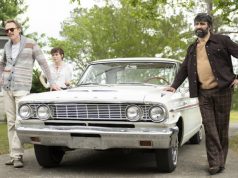I hoped “Bloody Sunday” would end with the U2 song of that name playing over the closing credits. I was not disappointed in that regard, nor, for the most part, with the film itself. A dreadful day in Irish history is given passionate, if somewhat flawed, treatment.
Bloody Sunday — Jan. 30, 1972 — was the start of the modern “troubles” in Ireland. Politician Ivan Cooper tried to lead a peaceful march through the city of Derry, protesting the strict manner in which Britain was governing Ireland. During the march, British troops fired at unarmed citizens, killing 13 of them. A half-hearted investigation was made, and those responsible were never punished.
Writer/director/cinematographer Paul Greengrass confines his film to the day itself. Whatever background is needed is given as we go; the consequences of what happened that day are left for other historians to tell. Greengrass employs a striking documentary style, which, combined with dead-accurate hairstyles and clothes, makes it so you’d never know the film wasn’t 30 years old, shot the day of the march. There isn’t even a musical score. Only the presence of some recognizable actors prevents this from looking like a very well edited home movie.
The idealistic Ivan Cooper is played with earnestness and conviction by James Nesbitt. Other figures include a young Catholic rebel named Gerry, and various military personnel. The cast, composed entirely of British actors, is huge; one senses they knew they were re-creating an important moment of history and sought to enact it with intelligence and grace.
It is hard to imagine staying with the film through its long pre-shooting stretches if one didn’t know the eventual outcome. There is a great deal of confusion — Greengrass forgets it’s possible to DEPICT chaos (which viewers like) without BEING chaotic (which turns viewers off). The ultra-thick accents are often difficult for American ears to decipher; here, the realistic style — which means not everyone has a microphone right next to his face — backfires a little.
But when the action truly starts, and innocent people are gunned down, it is horrifying. No question, Greengrass is on the side of the Irish. If the British troops had any reason for believing what they did was right, that point of view is not expressed here.
It is like a war movie, and also a bit like a disaster movie, where characters are introduced, trouble happens, and we see who lives and who dies. That it’s based on actual events and is a faithful retelling of them makes it all the more resonant.
B- (; )





